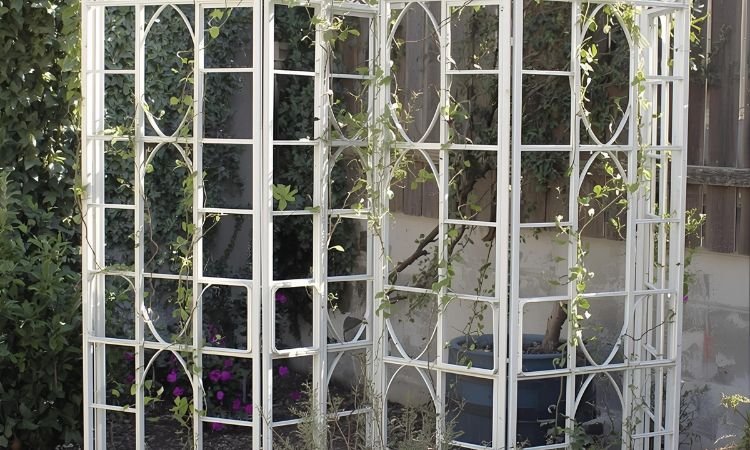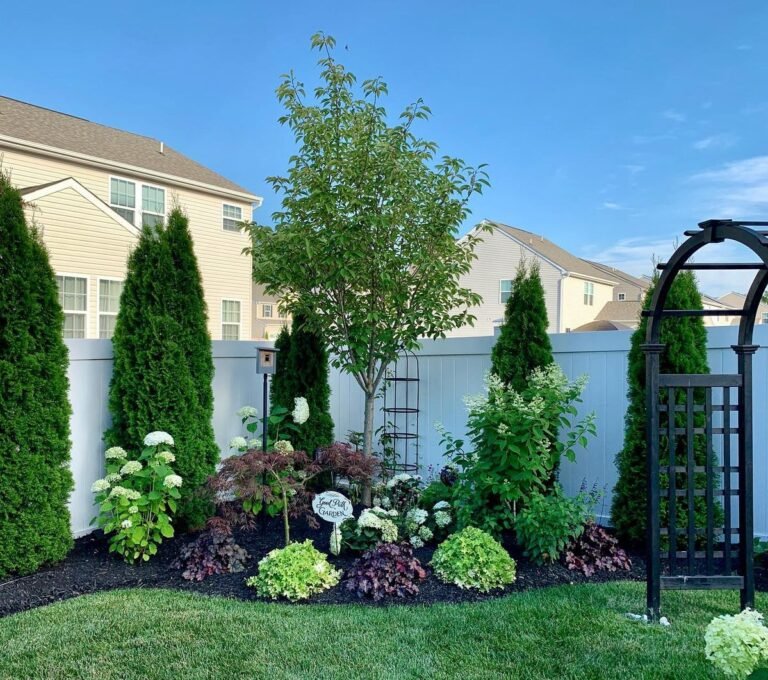Garden Divider That Create Structure and Privacy – 15 Awsome Ideas!

Open yards feel empty and undefined. Without clear zones, gardens lack the structure that makes outdoor spaces feel intentional and inviting. Everything blends together creating visual chaos rather than organized beauty.
Garden divider ideas solve this by creating distinct areas within your landscape turning flat expanses into rooms with purpose. These dividers add privacy, define functions, and create visual interest through vertical elements that break up horizontal spaces.
We’re covering 15 garden divider ideas that transform open yards into structured landscapes with character. These solutions work for various budgets, styles, and spatial needs creating separation without complete enclosure.
Why Garden Dividers Transform Outdoor Spaces
- Vertical Elements Add Dimensional Interest: Flat yards benefit dramatically from height variation creating layers that guide the eye upward. It’s like adding punctuation to sentences where dividers break monotony through structure. The vertical presence makes gardens feel more complex and designed.
- Defined Zones Increase Usable Space: Separating areas for dining, relaxing, and gardening makes each zone feel purpose-built rather than random. It’s like having multiple outdoor rooms versus one undefined space. The psychological boundaries encourage using different areas for different activities.
- Privacy Screening Enhances Comfort: Dividers block unwanted views from neighbors or streets making outdoor living feel more intimate and relaxed. It’s like drawing curtains where visual barriers create personal space. The privacy encourages spending more time outdoors comfortably.
- Wind and Noise Barriers Improve Conditions: Physical dividers reduce wind speeds and muffle sounds creating more pleasant microclimates within gardens. It’s like building natural air conditioning where sheltered zones feel more comfortable. The improved conditions extend outdoor season length.
15 Garden Divider Ideas
Create defined outdoor spaces with these garden divider ideas that add structure, privacy, and beauty to your landscape.
Living Hedge Walls
Plant evergreen or deciduous shrubs in continuous rows creating natural living barriers. The green walls provide privacy while adding oxygen and wildlife habitat. It’s like growing your own walls where nature provides the architecture.
Choose hedge plants suited to your climate—boxwood, privet, or holly for formal looks, hornbeam for taller screens. Space plants closely allowing them to grow together forming solid walls. This garden divider idea requires patience during establishment but provides long-term beauty and privacy naturally.
Vertical Wood Slat Screens
Install fence panels with evenly spaced vertical slats creating modern partial privacy. The gaps allow air and light through while blocking direct sightlines. It’s like venetian blinds standing upright where filtered views create interest.
Build screens using cedar or composite materials in natural or stained finishes. Space slats 2 to 4 inches apart balancing privacy with openness. This garden divider idea suits contemporary landscapes adding architectural lines that complement modern homes beautifully.
Climbing Vine Trellises
Construct sturdy trellises supporting climbing plants like clematis, jasmine, or climbing roses. The framework disappears beneath flowering vines creating romantic living screens. It’s like vertical gardens where plants become the walls themselves.
Build trellises using wood, metal, or wire mesh providing adequate support for mature plants. Choose vigorous climbers appropriate for your zone ensuring coverage within reasonable timeframes. This garden divider idea combines structure with blooming beauty providing seasonal interest year after year.
Bamboo Privacy Panels
Install natural bamboo fencing creating instant Asian-inspired screens. The vertical poles add texture while providing excellent privacy and wind protection. It’s like importing tropical aesthetics where natural materials create warm barriers.
Choose rolled bamboo fencing or individual poles mounted to frames. Seal bamboo for weather resistance extending lifespan in wet climates. This garden divider idea delivers quick installation and immediate privacy while developing attractive silver patina over time naturally.
Metal Laser-Cut Panels
Mount decorative metal screens with intricate cutout patterns creating artistic dividers. The perforated designs allow filtered views while adding sculptural interest. It’s like hanging outdoor artwork that functions as walls simultaneously.
Select Corten steel for rust patina or powder-coated aluminum for color options. Position panels to block specific views while framing desirable ones. This garden divider idea suits modern gardens adding contemporary sophistication through geometric or organic cutout patterns.
Planted Container Arrangements
Group large planters filled with tall grasses, bamboo, or small trees creating moveable barriers. The flexible arrangement allows seasonal changes and adjustments. It’s like furniture for gardens where containers provide portable structure.
Choose substantial containers preventing toppling in wind—concrete, stone, or heavy ceramic work well. Plant evergreens for year-round screening or deciduous varieties for seasonal variation. This garden divider idea provides flexibility repositioning elements as needs or aesthetics evolve.
Rustic Split Rail Fencing
Install traditional split rail fences defining boundaries without blocking views completely. The informal structure adds country charm while marking territories. It’s like drawing property lines with character where boundaries feel welcoming rather than forbidding.
Use cedar or locust wood resisting rot naturally without chemical treatment. Add wire mesh and climbing plants for increased privacy if desired. This garden divider idea works brilliantly in rural or farmhouse settings providing structure without formal appearance.
Gabion Stone Walls
Construct wire cages filled with stone creating contemporary industrial dividers. The stacked stones provide substantial presence while wire frameworks offer modern edge. It’s like building with geology where natural materials gain contemporary expression.
Fill gabions with river rock, crushed stone, or reclaimed materials matching your aesthetic. The porous structure provides drainage and habitat while standing permanently. This garden divider idea delivers modern sophistication through ancient building materials reimagined.
Living Willow Structures
Weave living willow branches creating organic dividers that root and grow. The traditional craft produces sculptural screens with natural curves. It’s like basketweaving at architectural scale where living materials create growing walls.
Plant willow whips in winter pushing them into moist soil and weaving patterns immediately. The branches root quickly establishing living structures within one season. This garden divider idea combines ancient techniques with contemporary design creating truly unique organic barriers.
Glass Panel Screens
Install frameless glass panels providing wind protection while maintaining views. The transparent barriers shelter without obstructing sightlines completely. It’s like invisible walls where protection doesn’t require visual sacrifice.
Use tempered glass rated for outdoor exposure mounting in sturdy aluminum or steel frames. The modern solution works beautifully with contemporary architecture. This garden divider idea maximizes wind protection while preserving precious views that solid screens would block.
Tall Ornamental Grass Beds
Plant masses of tall grasses like miscanthus, pampas, or fountain grass creating soft natural dividers. The flowing foliage moves with breezes adding motion and sound. It’s like installing living curtains that dance where nature provides the movement.
Group grasses in wide beds rather than single rows achieving screen effect more quickly. The airy texture provides privacy without heavy visual weight. This garden divider idea delivers seasonal interest through spring growth, summer flowering, and winter structure.
Woven Willow or Hazel Hurdles
Position traditional woven fence panels creating rustic charm. The wattle fencing adds cottage garden character while providing good screening. It’s like medieval barriers reimagined where ancient techniques feel current in cottage gardens.
Buy pre-made hurdles or weave your own using flexible branches. The natural material develops attractive silver-gray patina weathering beautifully. This garden divider idea suits informal gardens adding handcrafted character and substantial privacy naturally.
Slatted Horizontal Fence Panels
Build modern fencing using horizontal boards with consistent gaps between. The linear design creates contemporary style while allowing partial views. It’s like louvered shutters standing vertically where modern geometry meets function.
Use hardwood or composite materials in dark stains or natural finishes. Space boards evenly maintaining rhythm across entire installations. This garden divider idea complements contemporary homes adding clean architectural lines to outdoor spaces.
Pergola with Climbing Plants
Construct overhead pergola structures with vertical end sections supporting climbing plants. The architectural framework defines spaces while plants provide increasing privacy. It’s like building rooms without walls where structure suggests boundaries plants complete.
Build pergolas using cedar or pressure-treated lumber with posts sunk properly for stability. Train vines up posts and across overhead beams creating green ceilings. This garden divider idea provides shade and privacy while defining distinct outdoor rooms.
Moveable Trellis Planters
Create mobile dividers using trellis panels attached to wheeled planters. The flexible screens move easily repositioning as needed. It’s like furniture on wheels where seasonal changes or entertaining needs drive placement decisions.
Plant annuals or perennials climbing the trellises providing seasonal coverage. The mobility allows experimenting with different layouts without permanent commitment. This garden divider idea delivers flexibility that fixed installations can’t match for rental properties or indecisive gardeners.
Planning Successful Garden Divisions
- Consider Mature Plant Sizes: Research full-grown dimensions of hedges and screening plants avoiding surprises when immature plants reach maturity. It’s like planning for teenagers when planting babies where adult size matters most. The proper spacing prevents overcrowding requiring removal later.
- Balance Privacy with Air Circulation: Solid screens can create dead air zones while partially open dividers allow beneficial airflow. It’s like breathable fabrics where some permeability improves comfort. The balance prevents hot stagnant areas while maintaining adequate screening.
- Match Materials to Home Architecture: Choose dividers complementing your house style—rustic wood for farmhouses, metal for contemporary homes. It’s like coordinating accessories where garden elements should harmonize with main structures. The cohesive approach creates unified appearance across property.
- Plan for Maintenance Requirements: Select dividers matching your time and skill levels—hedges need trimming, wood requires staining, metal rusts differently. It’s like choosing pets where care needs should match available commitment. The realistic assessment prevents neglected dividers becoming eyesores.
Frequently Asked Questions About Garden Dividers
How Tall Should Garden Dividers Be?
Standard privacy screens measure 6 to 8 feet tall blocking most sightlines while 4 to 5 feet suffices for defining zones without total privacy.
Consider viewing angles from neighboring second-story windows potentially requiring taller screens. Local zoning may regulate maximum heights especially near property lines so check regulations before building.
What’s the Fastest Growing Privacy Hedge?
Leyland cypress, privet, and bamboo provide rapid screening growing 3 to 5 feet annually in proper conditions.
However, fast growth often means more maintenance and sometimes invasive tendencies. Consider moderately fast growers like arborvitae or hornbeam offering 1 to 2 feet annual growth with better manners and longevity.
How Do You Create Garden Dividers on Budgets?
Use found materials like reclaimed pallets, salvaged doors, or branches for rustic screens. Plant fast-growing bamboo or tall grasses in budget containers.
Build simple post-and-wire frameworks training inexpensive climbing annuals. The creativity and sweat equity substitute for expensive materials creating unique dividers with character.
Can Garden Dividers Reduce Noise?
Solid barriers like masonry walls or dense hedges reduce noise better than open screens, though no garden divider blocks sound completely.
Layering multiple screens—fence with hedge in front—improves sound dampening. The psychological benefit of visual screening often makes spaces feel quieter even when actual noise reduction is modest.
What Maintenance Do Different Dividers Require?
Living hedges need annual trimming and occasional feeding, wood screens require staining every 2-3 years, metal develops patina or needs repainting, bamboo may need thinning.
Glass panels require cleaning, stone structures need minimal maintenance beyond occasional repairs. Match divider choices to maintenance tolerance and available time honestly.
Creating Your Garden Structure
Garden divider ideas transform open yards into designed landscapes with intention and purpose. These vertical elements add the structure that makes gardens feel complete rather than empty. The division creates opportunities using outdoor space more fully through defined zones each serving specific purposes.
Start by identifying problem areas needing screening or open zones requiring definition. Consider mature sizes, maintenance needs, and aesthetic harmony with existing landscape and architecture. Plan installations in phases if budget constraints exist, completing most important sections first then expanding gradually.
Remember that garden dividers provide both practical benefits and aesthetic improvements. The best solutions solve functional problems while adding beauty that enhances your landscape design. The investment in proper dividers pays dividends through increased privacy, defined spaces, and improved outdoor living enjoyment. What garden zone needs division in your yard? Share your landscape challenges in the comments below!






